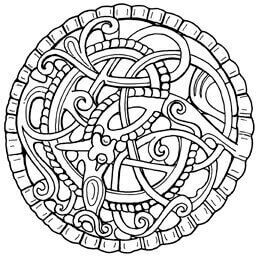Resources
Rituals in Asatru, Heathenry and Norse Paganism
Rituals are our way of communicating and connecting with the Gods, the spirits in the world around us and each other.
The rituals in Ásatrú, Heathenry and Norse Paganism are about creating community and harmony. They are how we reflect the benevolence of the Gods back to them and to one another. This doesn’t just apply to the rituals we do for specifically religious purposes, but also rituals we do to celebrate or commemorate special moments in our lives. We seek to create community and harmony whether we are celebrating a new child (Ausa Vatni) coming into your family, moving into a new house or mourning and remembering the life of someone we loved.
We don’t have a specific conversion ritual to Ásatrú, but you can think of your “first gift to the Gods” as your conversion.
One of the biggest questions we get is about how you convert to Ásatrú. Isn’t there some kind of ritual I can do? There isn’t a specific conversion ritual, but one way to mark your conversion to Ásatrú is to mark your first sacrifice as your moment of conversion. That is the moment you have chosen to actively engage in the gifting cycle. You have shown enough faith in the Gods to give them a gift. Why would you give a gift to something you didn’t believe in?
Welcome to Ásatrú.
This part of our resource library is where you can find helpful articles on the rituals we do, what sources we have for their existence in pre-Christian times and how these rituals are performed and used today. There are no restrictions for who may or may not perform these rituals based on perceived race, gender identity or ability. Anyone can be a Heathen.

Offerings
We also give offerings to ancestor spirits and spirits of the land and home. The world of Heathenry is alive with both mundane and sacred aspects.
Can I do Devotional Practices instead of Sacrifices?
Devotional practices are not offerings or sacrifices, they are activities people either don’t do regularly, or do a regular practice but in a particular way that puts someone in a frame of mind where they are focused on the holy aspect of what they are doing. Devotional practices could be something like “deadlifts for Odin” or it could be feeding the hungry for Njord.
These are not “sacrifices” but they’re devotional practices. They are incredibly important in someone’s religious life even though there aren’t many attestations of them in the historical records. Or maybe there are and we just miss them because we don’t know they are devotional practices.
You can do your deadlifts in the name of Odin, but that’s devotional practice, not sacrifice.
Do Heathens have Weddings and Funerals and stuff like that?
You’ve probably heard someone talk about how they want a “Viking Funeral.” Well, we hear that a lot too. We also hear about how people want a “Viking Wedding” and a “Viking Baptism” and a “Viking Bar Mitzvah.” And you’ve also probably heard a similar answer about how “well, we don’t have a lot of evidence for what people did back then…” They send you to read some Sagas and in about two weeks you’re back at square one with no idea for how to have a wedding or a funeral, but now with a few Sagas on your bookshelf now.
People can be really tricky about sharing this kind of stuff because they don’t want to commit the grievous sin of “Historical Inaccuracy” so we will just say this:
Modern Heathens have created many rituals as a community to address the needs of real people and to help people mark many different important moments in life.
Weddings
Our resource on weddings goes both through some of the historical background and the modern interpretations of a Heathen Wedding. It includes background on marriage, courtship and a template as well as a sample ceremony.
Funerals
Our resource on Funerals is an exhaustive look at all the sources we have on historical practice as well as several ideas for how one might conduct a funeral today in keeping with those traditions, as well as practical advice for how to actually get your papers in order for your final arrangements. (It’s not an easy thing to think about but important nonetheless)
Baby Naming
Áusa Vatni (sprinkling with water) is our name for a baby naming ritual, which is something similar to the baptism of a newborn. We have included both the historical background of the ritual as well as a full sample script as well as a sample ritual that was actually conducted.




